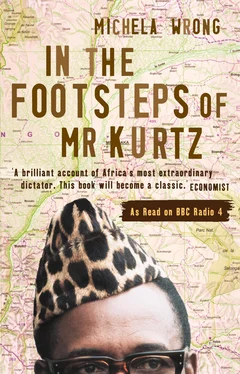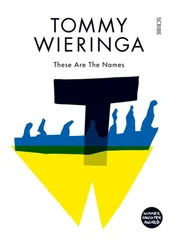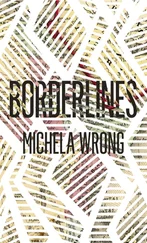1 ...6 7 8 10 11 12 ...15 The anger that prompted the toppling of these grandiose monuments by Zaireans who decided they preferred a capital dotted with empty plinths to one tainted by Belgium offers a hint that Mobutu should not be regarded as sui generis , a monster out of time and place. Yet you will find no trace or explanation of that popular fury back in Brussels, in the museum specially constructed to commemorate a truly extraordinary colonial episode.
Built at the turn of the century on the orders of King Leopold II, the only European monarch to ever personally own an African colony, the Royal Museum for Central Africa boasts one of the largest collections of Congolese artifacts in the world. But the quantity of items stored inside this elegant building in Tervuren – the Belgian equivalent of Versailles – has done nothing to prevent a strikingly simplistic vision of history from emerging.
On the day I visited, the woman handing out tickets inside the marble-lined entrance hall seemed surprised I wanted to see the permanent collection, rather than a special exhibition of West African masks on temporary display. Strolling under the gilded cupolas and tip-tapping my way through the halls designed by French architect Charles Girault, Leopold’s favourite, I began to see why even its staff might regard the museum as an anachronism and feel a sense of relief that a large number of the exhibits were currently hidden from view, undergoing refurbishment.
Political correctness, the modern sense that colonialism is something to be regretted rather than gloried in, had made the barest of inroads here. King Leopold’s bust, with its unmistakable spade-shaped beard and beak nose, stared with proprietary ferocity from frozen courtyard and chilly hall. Under his watchful eye, history was still being sieved through the mental filter of the nineteenth-century capitalist and driven missionary – colonialism as economic opportunity and soul-saving expedition, all wrapped up into one convenient package.
One section, dedicated to Congo’s flora and fauna, displayed scraps, sheets and lumps of natural rubber. But there was no mention of the methods used to extract the raw material or ensure a steady supply back to Europe. Wall paintings showed Congo’s jungle being stripped to make room for copper mines, but the struggle over mineral assets between Belgium and the post-independence government did not feature. Was it a symbolic accident or deliberate, I wondered, that the lights in the rooms displaying the battered suitcase and worn khaki bag used by Stanley were barely working, discouraging any lingering over Congo’s controversial pioneer?
Sly omission blurred effortlessly into blatant wishful thinking. In the Memorial Hall, where the paint was peeling off the ceiling, labels promised to reveal ‘the King’s intentions towards the Congo’. But the anti-slavery medals struck at Leopold’s behest made the same point as the rusting slave chains in the glass cases and the melodramatic tableaux vivants, all buxom negro wenches and noble savages wincing under the whip of the sneering Arab overseer. Leopold, it seemed, colonised the Congo not for commercial reasons or vainglorious imperialist ambition, but to snuff out the barbaric slave trade that for centuries had robbed central Africa of its strongest and its best.
I had expected rose-coloured spectacles, but this complacent rewriting of Belgium’s past took me by surprise. No explanation here, then, for why things went so wrong under Mobutu. This was a tale – the wall frieze commemorating the hundreds of young Belgians who found their graves in the Congo Free State made clear – of selfless commitment and higher motives.
From this self-satisfied tableau, one item nonetheless grabbed my attention. Under the roll-call of dead heroes, an 1884 painting by Edouard Manduau, a painter unknown to me, injected an incongruous note. The artist, who had clearly been somewhat disturbed by his brush with the Congo, had painted a native being held to a post. On his knees, writhing, he is being whipped until the blood flows down his back. Looking on without expression is a white man, scientifically taking notes.
In the whole museum, it was the only object on display that had the sour ring of truth. Those bright oils, that unexpected depiction of what was clearly an everyday, a banal event, pointed in a very different direction, one that would show how the seeds of Mobutism found fertile ground in which to sprout.
Jules Marchal knew all about watching coolly as a man was whipped. As a young district commissioner working in the Congo in the 1950s, he used to order labourers who had failed to meet the cotton quotas set by the Belgian state to be punished with the chicotte, a whip made from a strip of hippopotamus hide that had been dried in the sun. Applied sparingly, it flayed the skin and left permanent scars; used enthusiastically, it could kill.
‘We would tour the country, taking our prison with us and then we’d call the villagers to assemble and we would beat three or four of our prisoners to show them what could happen to them,’ he recalled, with a rueful shake of the head. ‘I used that punishment very sparingly. But its effect was terrible. We were so proud to be members of the administrative service, we felt so powerful. But all our power had its roots in the chicotte.’
Shame and guilt have a long reach. Nearly half a century after the events, Marchal was still trying to expunge what he did as a thoughtless young administrator flush with the excitement of an exotic posting and overwhelmed by new responsibilities. Long since retired, he had dedicated the previous twenty years to contradicting the version of history presented at the Royal Museum for Central Africa, a white-washing so clumsy it prompted an explosion of exasperated contempt. ‘It’s ridiculous! They even show an Arab trader whipping a slave! Absurd,’ he snorted.
I had spotted Mr Marchal’s name in the historical section of one of Brussels’s bookshops, something of a miracle in itself, I was subsequently to discover, given his self-imposed low profile. His name had also cropped up in King Leopold’s Ghost , the bestseller by US author Adam Hochschild, which was creating a stir amongst the Brussels intelligentsia in 1998. After my visit to the museum, I wanted to meet the man campaigning, virtually single-handed, to awaken a slumbering national conscience.
He had given me careful instructions over the phone, speaking with that slight Belgian twang that always sounds vaguely comic to anyone used to hearing French as spoken by Parisians. ‘You want to get off at St Truiden. But make sure if you take the train to Liège that you sit in the right part, as the train splits in two and some of my visitors have gone missing that way.’
An hour and a half out of the capital, I was already a world away from the smart shopping streets of French-speaking Brussels. This was fruit-producing Flanders, proud of its Flemish identity and language, resentful and suspicious of Francophone dominance. The train slid past frosty piles of mangelwurzels, snow-dusted fields and rows of denuded orchards, stopping at every sleepy station.
Now a portly pensioner, Mr Marchal had a distinguished career behind him. After nearly two decades in Zaire, he became a diplomat, rising to the rank of ambassador. His were not the easy postings: he served in Sierra Leone, Ghana, Chad, Niger and Liberia. His wife, who nonetheless remembered their years in Africa with huge nostalgia, still drove the ageing blue Mercedes that was the ambassador’s car on their last foreign assignment.
His earlier responsibilities made his new role as iconoclast all the more unexpected. For Mr Marchal, the former career diplomat, was busy energetically kicking the system that had sustained him. Trawling through the national archives, basing his findings on official memoranda, private correspondence, diaries kept by Belgian colonial agents, he was bent on exposing what he believed was the most brutal colonial system ever practised on a continent which saw more than its fair share of oppressive regimes.
Читать дальше












